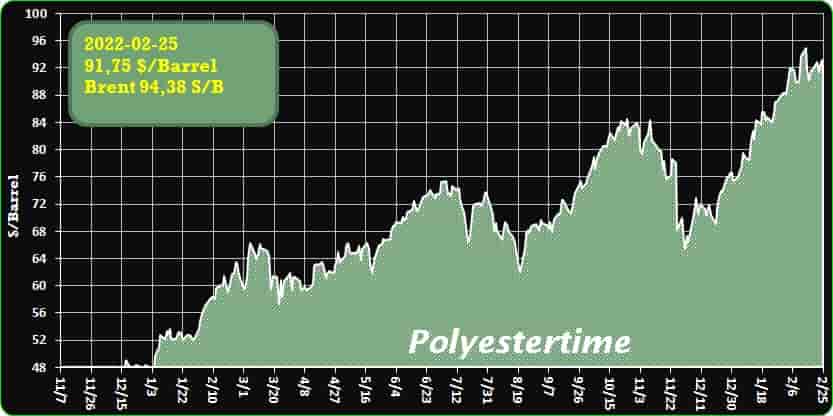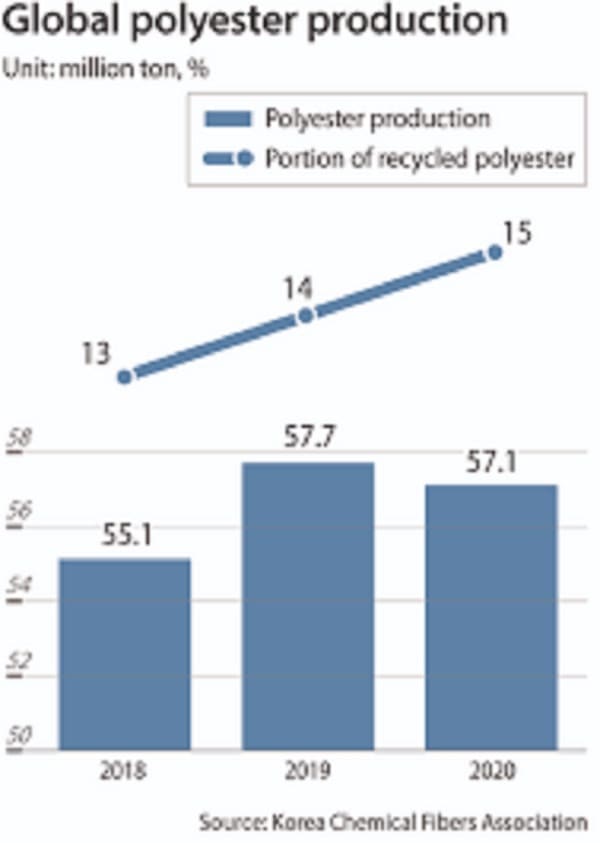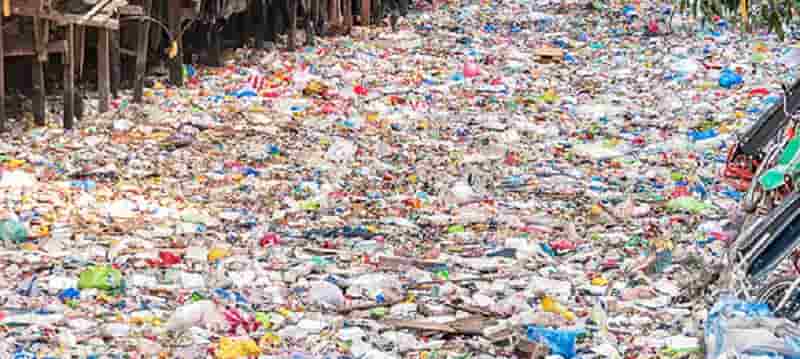Global-Polyester-Production – PET-bottle 25-02-2022 - Arhive
Global-Polyester-Production – PET-bottle
Crude Oil Prices Trend

-Why throw your water bottle away when you can wear it
Plastic bottles are a source of pollution when thrown away, but they can be a source of new fabric when properly recycled.
A growing number of chemical and textile companies in Korea are finding new opportunities to manufacture environmentally friendly textiles with discarded plastic bottles which are then made into apparel, shoes and bags among others.
These eco-friendly textiles may be more expensive then their chemical-made counterparts, but their quality as well as growing consciousness about the environment among consumers are giving them a greater chance to establish themselves as a substantial business. Global-Polyester-Production – PET-bottle
According to the Korea Chemical Fibers Association, global production of all types of polyester has showed little growth since 2017. Its output was at 57.1 million tons in 2020 compared to 55.1 million tons in 2018.
Of the total, the portion of recycled polyester continued to grow from 13 percent to 15 percent between 2018 and 2020.
U.S. market tracker Grand View Research also projected the eco-friendly fiber market to reach $700 billion by 2025, expanding at an average rate of 10 percent per year.
In Korea, Hyosung TNC, best known for its spandex product, has been pioneering the market.
In 2008, the company launched a separate brand for eco-friendly textiles — nylon, polyester and spandex — under the name Regen and has been sourcing its products to various fashion labels ranging from outdoor brands like North Face and National Geographic to a trendier handbag brand Pleats Mama.
Hyosung TNC mechanically recycles which means the collected plastic bottles, after being cleaned of residue, labels and caps, are shredded into small rice-sized flakes and melted down to create thread.
Their initial color is white but can be colored into 30 different shades, according to the company. Global-Polyester-Production – PET-bottle
For a stable supply of plastic bottles, Hyosung TNC is collaborating with city governments including on Jeju Island and in Seoul. Its source of textiles has recently extended to plastic bottles and fish nets collected from the ocean by joining forces with Yeosu Gwangyang Port Authority.

-9% of global plastic waste is recycled while 22% is ‘mismanaged’ – OECD
The world is producing twice as much plastic waste as two decades ago, with only 9% successfully recycled, according to a new OECD report.
Ahead of UN talks on international action to reduce plastic waste, the Organisation for Economic Co-operation and Development’s (OECD) first Global Plastics Outlook suggests that as rising populations and incomes drive a ‘relentless increase’ in the amount of plastic being used and thrown away, policies to curb its leakage into the environment are ‘falling short’. Global-Polyester-Production – PET-bottle
Almost half of all plastic waste is generated in OECD countries, according to the Outlook. Plastic waste generated annually per person varies from 221 kg in the United States and 114 kg in European OECD countries to 69 kg, on average, for Japan and Korea.
Today’s OECD report clearly shows the plastic pollution crisis is getting worse
Most plastic pollution comes from ‘inadequate’ collection and disposal of larger plastic debris known as macroplastics, it says, but leakage of microplastics (synthetic polymers smaller than 5 mm in diameter) from things like industrial plastic pellets, synthetic textiles, road markings and tyre wear are also a ‘serious concern’.
OECD countries are behind 14% of overall plastic leakage, according to the report. Within that, OECD countries account for 11% of macroplastics leakage and 35% of microplastics leakage. Global-Polyester-Production – PET-bottle
The Outlook notes that international co-operation on reducing plastic pollution should include supporting lower-income countries in developing better waste management infrastructure to reduce their plastic leakage.
‘Rebounded consumption’
The report finds that the COVID-19 crisis led to a 2.2% decrease in plastics use in 2020 as economic activity slowed, but a rise in littering, food takeaway packaging and plastic medical equipment such as masks has driven up littering.
As economic activity resumed in 2021, plastics consumption has also rebounded.
Reducing pollution from plastics will require ‘action’, it says, and international cooperation, to ‘reduce plastic production’ – including through innovation, better product design and developing environmentally friendly alternatives, as well as efforts to improve waste management and increase recycling.
Bans and taxes on single-use plastics exist in more than 120 countries but are not doing enough to reduce overall pollution, OECD says.
It says most regulations are limited to items like plastic bags, which make up a tiny share of plastic waste, and are more effective at reducing littering than curbing plastics consumption.
Landfill and incineration taxes that incentivise recycling only exist in a minority of countries. The Outlook calls for greater use of instruments such as Extended Producer Responsibility schemes for packaging and durables, landfill taxes, deposit-refund and Pay-as-You-Throw systems. Global-Polyester-Production – PET-bottle
Most plastics in use today are virgin – or primary – plastics, made from crude oil or gas, it says. Global production of plastics from recycled – or secondary – plastics has more than quadrupled from 6.8 million tonnes (Mt) in 2000 to 29.1 Mt in 2019, but this is still only 6% of the size of total plastics production.
It says more needs to be done to create a ‘separate and well-functioning market’ for recycled plastics, which are still viewed as substitutes for virgin plastic.
Setting recycled content targets and investing in improved recycling technologies could help to make secondary markets more competitive and profitable.

-Why throw your water-bottle away when you can wear it
-9% of global-plastic-waste is recycled while 22% is ‘mismanaged’ – OECD
–Ukraine-Russia, polyethylene and no end to history
–Vietnam’s-NSRP closes PP plant after fire hits refinery
–Symphony-Environmental launch nutritional-supplement bottles using d2w biodegradable technology
–ERI’sShegerian pens op-ed on battery-recycling
–YKK Announces New Collection Of Recycled-Zippers Made Using ECONYL®-Regenerated-Nylon-In-Europe
–New report: PET, the most circular-of-all-plastics, is far from real-circularity
Global-Polyester-Production – PET-bottle
